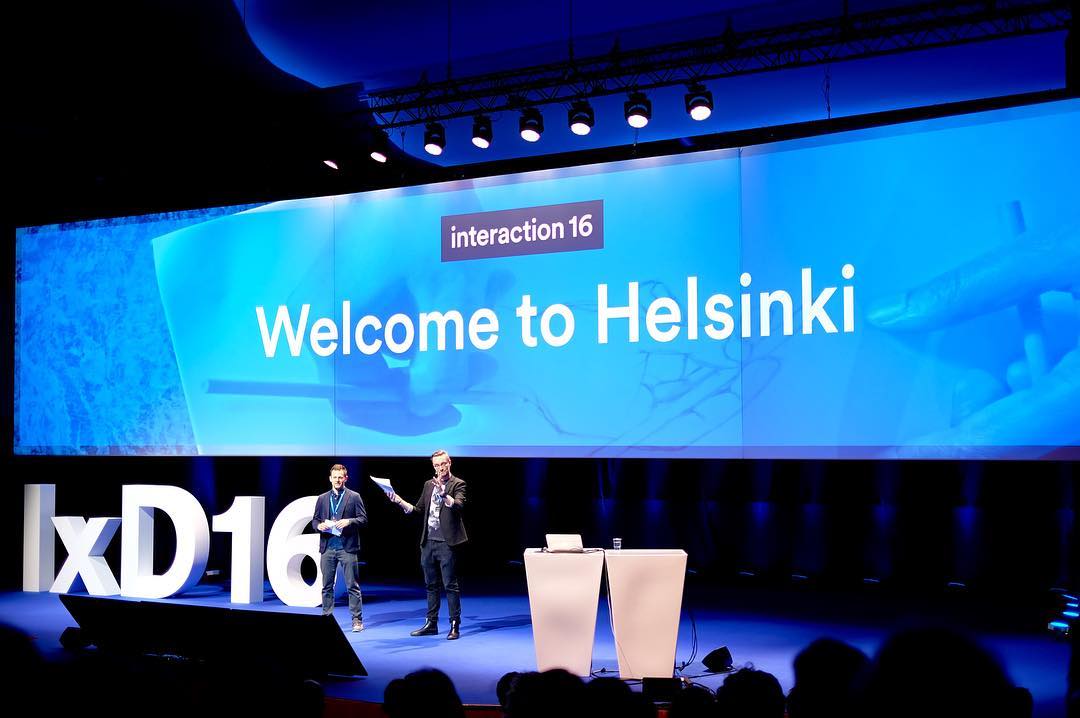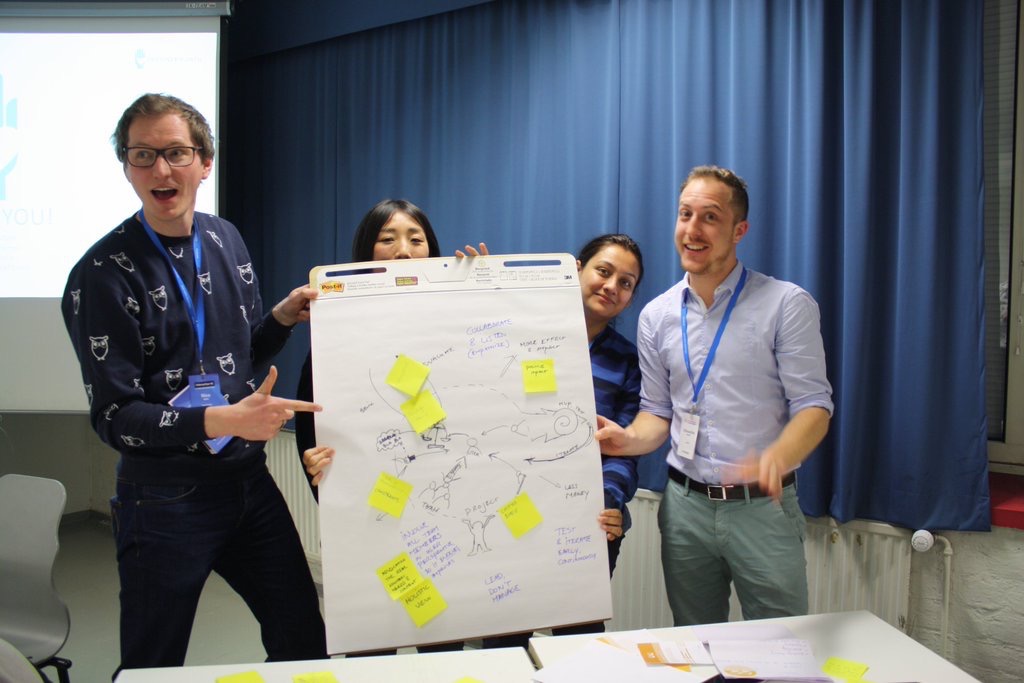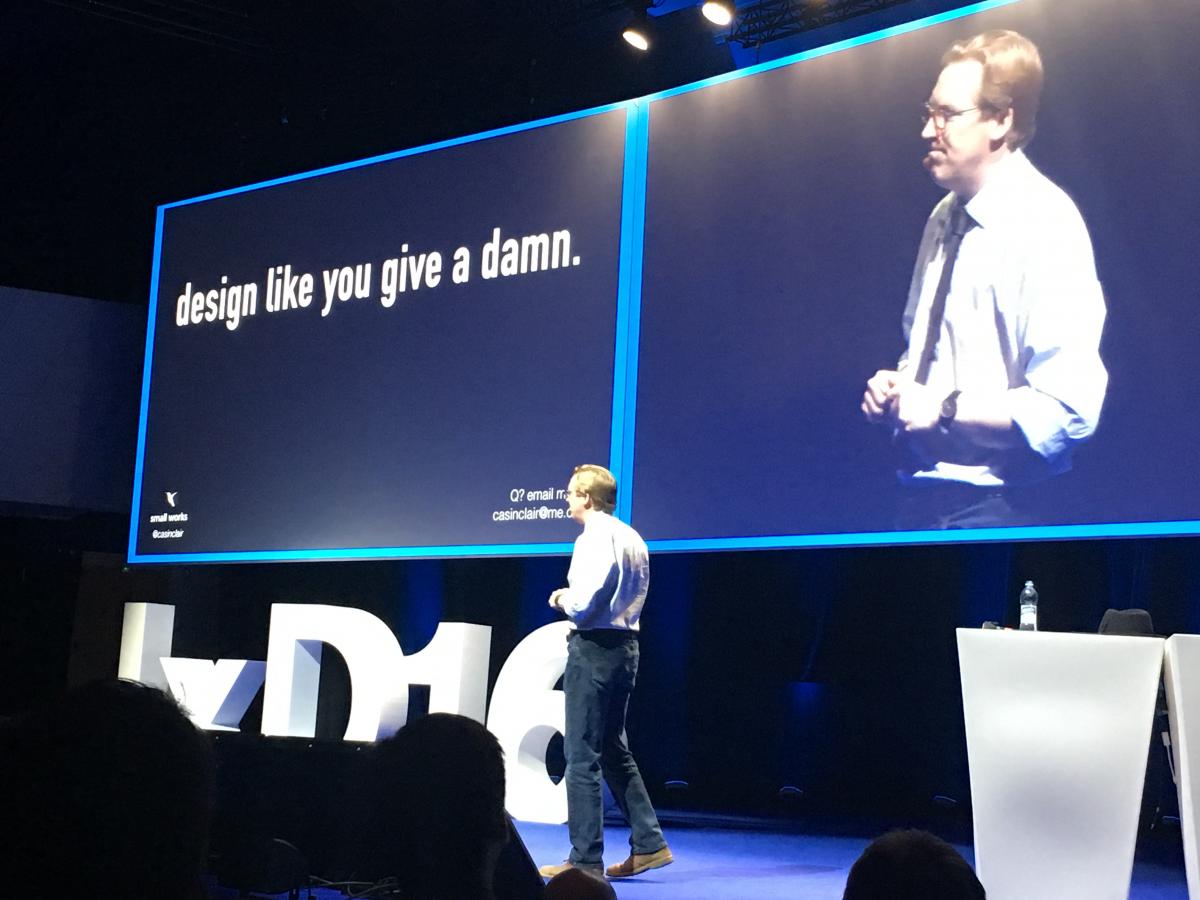22 - 3 - 2016
Back from Helsinki, back from Interaction16. With the chills. Not from the cold, but from being inspired: what a week to remember! The program was impressive and everything around it was fun, tasty and very enjoyable.

Leitmotiv during the four-day program was 'thoughts about the future', how will interaction design evolve (and computerize) as a profession and what will designers be doing. How the human centered design process is becoming increasingly vital in a growing number of areas (technical startups, internet of things, robotics, city development). How ethics are an essential factor: "design like you give a damn".
Recurring subjects during the conference:
- internet of things
- ethics / design for good
- machine learning / AI / Robotics
- conversational UI
Tuesday
Went to listen to Josh Clark (@bigmediumjosh) in his workshop on the internet of things: "What if it was magic". Worked with the AEIOU model: activities / environments / interactions / objects / users. Can we turn connected devices into genuine magical objects? "Yes, that would be magic!"

Later that day, Samantha Dempsey and Ciara Taylor of Mad*Pow presented a workshop on ethics. Via a role playing game we were easily coached into having ethical discussions. In the end, we formulated our own Hippocratic oath for designers.

Wednesday
Joe Macleod (@mrmacleod) talked about closure design, which means special care for the design of endings and finalizations (like cancelling a subscription). Also, the possible contribution to the decrease of (infinite) growth, consumerism and capitalism.
Antti Oulasvirta (@oulasvirta) presented his research on the computerization of the design process. At first, we were dazzled by mathematical formulas, but soon we learned that he is well on his way in the development of an "optimizer" tool that will give back wireframes if you feed it requirements. We will need to think about our role as designers if wire framing and prototypes become largely computerized. Answer: we will be exploring, researching and talking to people about exact purposes and goals, to formulate effective requirements. Fortunately, this still requires a human's touch.
Alexandra Deschamps-Sonsino (@iotwatch) calls upon designers to reach out to and support the numerous internet of things startups. Many of these startups are based on technology and by no means human centered. Thus, our contribution here can prove to be invaluable. Watch on vimeo.
Also worth following:
-
John Waterworth of gov.uk, on their pattern library and design principles. Learned about their "one thing per page" strategy.
Thursday
Kate Darling (@grok_) wondered whether robots, which are becoming more and more integrated in our lives, will change us. Will living with robots lead to ethical or behavioral changes in humans? Many interesting examples. Kate argued that we shouldn't listen to Alexandra Deschamps-Sonsino and stay away from IoT startups, and instead join organizations that focus on human-robot interactions. Watch on vimeo.
Pablo Honey (@pablohoneyhoney): "cities are for people". Cities will expand, therefore it is crucial that we focus on a human centered development of cities.
Joshua Seiden (@jseiden), you know, of "Lean UX", talked about learning by (just) doing, taking action. Formulate what it is you want to investigate and learn, quick and short, and then put something out there, live, to learn from. To iterate. Focus on what it is you want to know and achieve, not on the features. "Manage outcomes, not features" and "allow the brand to follow". In other words, first find out if the concept is viable, then move on to branding and design. Watch on vimeo.
Also fascinating:
- But not so much my thing (cars... well, a necessary evil): John Rousseau on the autonomous car. In 2020 it will be life as we know it, but there will still be a mix of regular vehicles, semi-robotic vehicles (where drivers can still take control of the wheel) and fully autonomous vehicles. Interesting concept sketches of how a semi-robotic car can take over the wheel of a driver, and give it back again.
-
Sumier Phalake: Assisting Nepal after the earthquake: Lessons learned from applying design thinking in a post-disaster context.
Friday
Tricia Wang (@triciawang) made me think about perspectives. Everybody has his own perspective, no-one is objective. Even big data, which is often assumed to be neutral, isn't that, as it is always presented and composed according to a particular frame or set of rules. "What is measurable isn't what is valuable". Watch on vimeo.
Also worth following:
-
Alper Cugun on conversational UIs, and, more specifically, on his project Vrije vogels, een game voer vrijheid. Cugun on the rise of conversational UIs: "the revenge of Clippy" :-).
Marcel Schouwenaar (@TheIncMac) told us about his (not very successful as of yet) sharing platform project and his preliminary research that preceded it. Useful observations. People find it important to share items, but low-costs and the convenience of buying a product is still decisive. Good practices? Joining existing social structures, neighborhood projects, community desks, etc. Also, activating neighbors to participate, invent a game that requires cooperation and teamwork.
Also worth following:
-
Kaleem Khan was a little unorganized (maybe because he arrived thirty minutes late), but his message on the ethical sides of big data and robotics was worth the wait. He also talked about the pace layer model: fashion / commerce / infrastructure / governance / culture / nature. "Design must be meaningful", "integrity is the essence of everything successful" and "design serves humans".
-
Emmi Laakso en Phillip Tiongson: Nature’s Notifications: What technology can learn from a buzzing bee and a thunderclap.
Cameron Sinclair (@casinclair) was the last keynote speaker and tremendously funny and inspiring. In his high speed presentation, he offered examples of humanitarian projects (like working with parents in a refugee camp to build a school for their children in a minimal period of time, leaving the UN no time to react and request all sorts of paperwork, which could take up to 12 days to complete...). "Design, build, empower", "Design is a political act", "The most sustainable building is one that is loved" and "6 billion people are in dire need of good design". Do we wish to design for virtual reality or actual reality? Let us work on real problems. "Design like you give a damn". Chills. And a standing ovation. Watch on vimeo.

